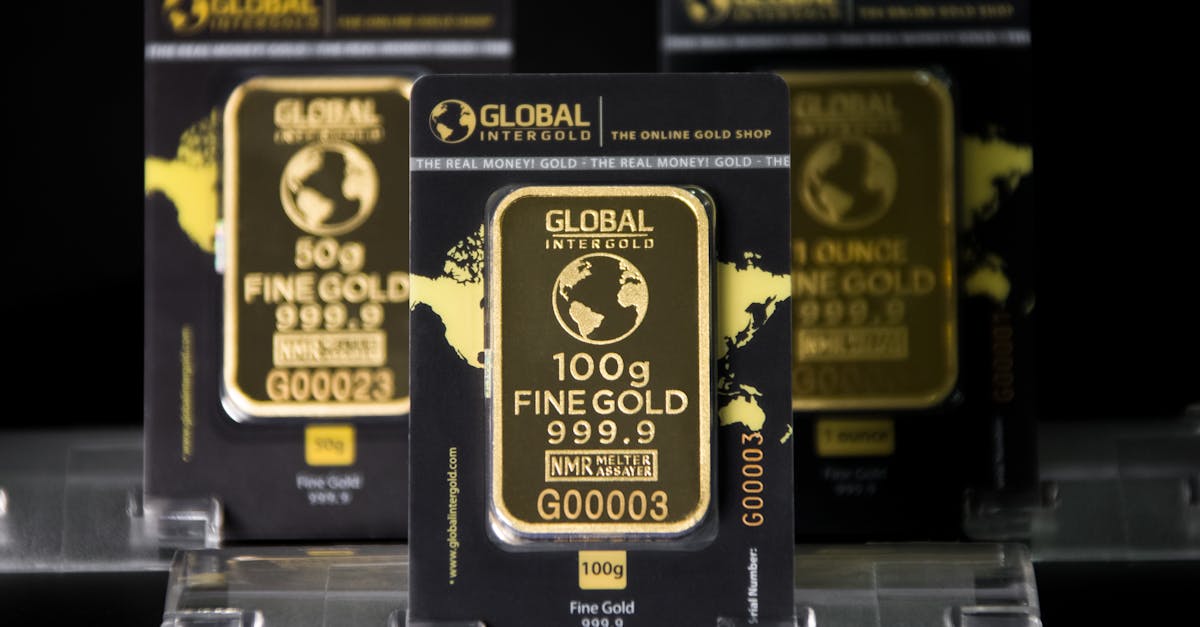Navigating the Golden Maze: A Comprehensive Guide to Gold Investment Options

Gold has fascinated civilizations for centuries, alluring investors with its perceived safety, stability, and potential for growth. However, navigating the intricate world of gold investments can be a daunting task. This comprehensive guide aims to simplify the complexities, empowering you to make informed decisions and unlock the true potential of gold within your portfolio.
Gold, in its various forms, caters to a wide range of investment objectives. From the tangible allure of physical gold to the fractional convenience of ETFs and the speculative excitement of mining stocks, this article will delve into the nuances of each option. We’ll unveil the unique characteristics, advantages, and considerations associated with each investment vehicle, equipping you with the knowledge to confidently choose the path that aligns with your financial goals.
As we embark on this journey through the gold investment spectrum, it’s essential to remember that every option carries its own set of risks and potential rewards. By understanding the intricacies of each choice and carefully weighing your preferences, you can optimize your investment strategy and harness the power of gold to enhance your financial well-being.
Key Insights
Key Points:
- Gold offers a diverse range of investment options, from physical assets to ETFs and mining stocks, each with unique characteristics and risk-reward profiles.
- Physical gold provides tangible ownership and a hedge against inflation, but it requires secure storage and insurance.
- Gold ETFs offer fractional gold ownership and liquidity, but they may come with management fees and tracking errors.
- Gold mining stocks provide the potential for higher returns but also carry higher risks associated with mining operations and gold price fluctuations.
- To make informed gold investment decisions, consider your investment goals, risk tolerance, and time horizon, and don’t hesitate to seek professional advice if needed.
1. Unveiling the Gold Investment Spectrum
The world of gold investment stretches far beyond the traditional image of gold bars stashed away in vaults. Today, a diverse array of gold investment options cater to a wide range of investor preferences and risk appetites. Each option carries its own unique characteristics, advantages, and considerations, and understanding these nuances is crucial for making informed investment decisions.
Physical gold, in the form of bars, coins, and jewelry, offers the tangible assurance of owning the precious metal itself. It provides a hedge against inflation and economic uncertainty and can serve as a store of value during times of financial turmoil. However, physical gold requires secure storage and insurance, and its liquidity may be limited compared to other investment options.
Exchange-traded funds (ETFs) offer an alternative way to invest in gold without the hassle of physical storage. Gold ETFs track the price of gold and provide investors with fractional ownership of the underlying metal. They offer high liquidity and diversification benefits, making them a popular choice for both short-term trading and long-term investments. However, ETFs are subject to management fees and may not always perfectly track the spot price of gold.
2. Physical Gold: The Tangible Asset

Physical Gold: The Tangible Asset
Investing in physical gold, whether in the form of bars, coins, or jewelry, offers a tangible way to own the precious metal and hedge against economic uncertainties. Physical gold has been a store of value for centuries and is often sought after during times of financial turmoil. Unlike paper investments, physical gold cannot be inflated away and provides a sense of security that digital assets may not offer.
Gold bars and coins are popular choices for investors looking for a pure and convenient way to invest in gold. They are available in various sizes and weights, making them suitable for a range of budgets. Gold jewelry, while primarily decorative, also has investment potential, especially in the form of heirloom pieces or collectible coins. However, it’s important to note that the value of gold jewelry may be influenced by factors beyond the gold content, such as craftsmanship and design.
When investing in physical gold, it’s crucial to consider factors such as storage, insurance, and liquidity. Physical gold requires secure storage to prevent theft or loss, and insurance may be necessary to protect your investment. Additionally, the liquidity of physical gold may be lower compared to other investment options, as it may take time to find a buyer when you need to sell.
3. Exchange-Traded Funds (ETFs): Fractional Gold Ownership
Gold ETFs offer an alternative way to invest in gold without the hassle of buying, storing, and insuring physical gold. These ETFs track the price of gold and provide investors with fractional ownership of the underlying metal. Unlike physical gold, ETFs can be bought and sold easily on the stock exchange, offering high liquidity and the convenience of investing in smaller amounts.
One of the main benefits of gold ETFs is their diversification benefits. ETFs typically hold a large number of gold bars, which reduces the risk associated with investing in a single bar or coin. Additionally, some gold ETFs may invest in a basket of gold-related assets, such as mining stocks, which can further diversify the investment. Gold ETFs also offer lower storage and insurance costs compared to physical gold, making them a more accessible option for many investors.
However, it’s important to note that gold ETFs come with their own set of considerations. ETFs are subject to management fees, which can reduce returns over time. Additionally, the value of gold ETFs is still tied to the price of gold, which can be volatile. ETFs may also not always perfectly track the spot price of gold, and their liquidity may be affected by market conditions.
4. Jewelry: Beauty with a Gold Lining

Jewelry: Beauty with a Gold Lining
Gold jewelry has long been prized not only for its aesthetic appeal but also for its potential as an investment. While the primary purpose of jewelry is adornment, investing in high-quality gold pieces can provide a tangible and wearable asset that can appreciate in value over time. Gold jewelry offers a unique combination of beauty and financial potential, making it a popular choice for those looking to diversify their portfolios and express their personal style.
When considering gold jewelry as an investment, it’s important to strike a balance between aesthetics and financial returns. While intricate designs and gemstones may enhance the beauty of a piece, they can also impact its resale value. Investors should focus on classic, timeless designs with a high gold content. Hallmarks and certificates of authenticity can provide assurance of the gold’s purity and quality.
It’s also crucial to consider the liquidity of gold jewelry compared to other investment options. Selling gold jewelry may take longer than selling stocks or ETFs, and the price you receive may be influenced by factors such as the design, condition, and local market demand. However, for those willing to hold their investment for the long term, gold jewelry can be a valuable and aesthetically pleasing addition to a diversified portfolio.
5. Mining Stocks: Tapping into Gold Production
Investing in gold mining stocks offers a unique way to participate in the gold market and potentially profit from the extraction and production of gold. Gold mining companies are involved in the exploration, mining, and processing of gold ore, and their stock prices are influenced by the price of gold and the company’s operational performance.
Investing in gold mining stocks can be a more speculative investment compared to investing in physical gold or ETFs. Mining companies face various risks, including geological uncertainties, operational challenges, and fluctuations in the price of gold. However, they also offer the potential for higher returns if the company is успешной in discovering and extracting gold reserves efficiently.
When considering investing in gold mining stocks, it’s important to research the companies thoroughly and understand their financial狀況, production history, and management team. Diversifying your investments across multiple mining companies can help mitigate some of the risks associated with this sector.
6. Weighing the Options: Finding the Right Fit
Weighing the Options: Finding the Right Fit
When choosing the right gold investment option for your portfolio, it’s essential to carefully consider your investment goals, risk tolerance, and time horizon. Different gold investment options offer varying levels of liquidity, volatility, and potential returns. Here’s a brief comparison to help you make an informed decision:
Physical gold: Physical gold, in the form of bars, coins, or jewelry, offers a tangible and secure way to invest in gold. It is less liquid than other options but provides a hedge against inflation and economic uncertainty. The volatility of physical gold is generally lower compared to other gold investments.
Gold ETFs: Gold ETFs provide a convenient and liquid way to invest in gold without the hassle of physical storage. They offer diversification benefits and are suitable for both short-term trading and long-term investments. However, gold ETFs may have management fees and may not always perfectly track the spot price of gold.
Gold mining stocks: Gold mining stocks offer the potential for higher returns but come with higher risks. The success of mining companies depends on factors such as the price of gold, operational efficiency, and geological uncertainties. Gold mining stocks are more volatile than physical gold or ETFs and are suitable for investors with a higher risk tolerance and a long-term investment horizon.
7. Decisive Investing: Overcoming Paralysis
Decisive Investing: Overcoming Paralysis
Overcoming decision paralysis when it comes to gold investment can be challenging, but it’s crucial to make informed and timely decisions to maximize your investment potential. Here are a few actionable steps and strategies to help you overcome this obstacle:
1. Define your investment goals: Clearly define your financial objectives, time horizon, and risk tolerance. This will help you narrow down the gold investment options that align with your specific needs and goals.
2. Research and educate yourself: Thoroughly research different gold investment options, including their advantages, disadvantages, and historical performance. Knowledge is power, and it will empower you to make confident investment decisions.
3. Seek professional advice if needed: Don’t hesitate to consult with a financial advisor or investment professional if you need guidance or have complex financial circumstances. They can provide personalized advice and help you create a tailored investment plan.
Gold Investment Quiz
1. Which of the following is NOT an advantage of investing in physical gold?
(a) Tangible asset (b) High liquidity (c) Inflation hedge
2. True or False: Gold ETFs offer fractional gold ownership without the need for physical storage.
(a) True (b) False
3. Which type of gold investment is generally considered more speculative and volatile?
(a) Gold mining stocks (b) Gold jewelry (c) Gold ETFs
Answer Key:
- (b) High liquidity
- (a) True
- (a) Gold mining stocks
Table of Key Insights
| Key Insight | Description | |—|—| | Diversity of Gold Investment Options | Gold offers a wide range of investment choices, each with distinct features and risk-reward profiles. | | Tangible Ownership and Inflation Hedge | Physical gold provides a physical asset and a hedge against inflation, but it requires secure storage and insurance. | | Fractional Ownership and Liquidity | Gold ETFs offer fractional gold ownership and liquidity, but they may come with management fees and tracking errors. | | Higher Returns and Higher Risks | Gold mining stocks have the potential for higher returns but also carry higher risks associated with mining operations and gold price fluctuations. | | Informed Investment Decisions | To make informed gold investment decisions, consider your investment goals, risk tolerance, and time horizon, and don’t hesitate to seek professional advice if needed. |

0 responses to “Gold Investment Options: Simplifying the Complexities”